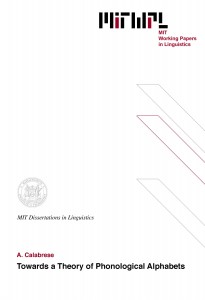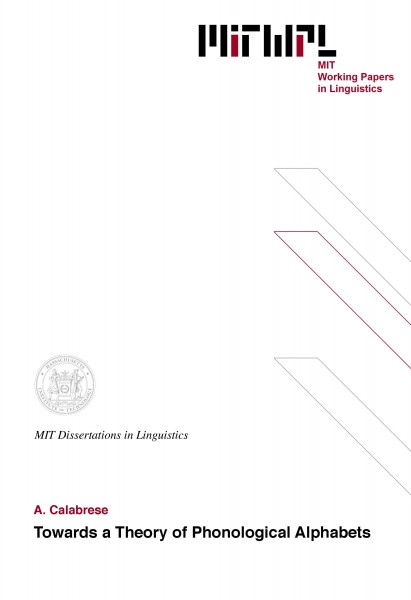Towards a Theory of Phonological Alphabets
A. Calabrese, 1988
One of the basic tenets of phonology is that every language has an inventory of phonological segments used to distinguish lexical items in underlying representations. I call the inventory of phonological segments of a given language the phonological alphabet of that language. Each phonological alphabet is always organized according to a precise pattern and has a well-defined structure. In this thesis, I argue that negative conditions on feature cooccurrence are the correct means to represent the structure of a phonological alphabet. I call these negative conditions on feature cooccurrence filters. An example of a filter is the following: (i) *[+low, –back]. (i) represents the fact that the feature values [+low] and [–back] cannot occur together in the same feature bundle. I hypothesize that when a filter holds in a given language, the phonological segment which is characterized by the configuration of features disallowed by the filter is absent from the phonological alphabet of that language. Thus, I represent the fact that the low front vowel /æ/ is absent from the phonological alphabet of Italian by hypothesizing that the filter *[+low, –back] holds in Italian.
I propose that there is a set of filters provided by Universal Grammar, which I call UG filters. I propose that UG filters are hierarchically ordered: the more complex a phonological segment is, the higher the filter that excludes it is in the hierarchy. The hierarchy of UG filters is also intended to account for Jakobson’s (1941) observations on language learning and loss, as well as his observations on the universal implications about the structure of phonological alphabets.
In Chapter 1, I demonstrate that hierarchically ordered UG filters are needed to represent generalizations about phonological alphabets. In this chapter, I also argue that Universal Grammar provides a set of rules that have the function of repairing configurations of features which violate filters. I call these rules cleanup rules. By hypothesizing an interaction among phonological rules, filters and cleanup rules, I account for several phonological phenomena in a straightforward way. Finally, I attempt to account for situations in which filters can block the application of rules and how configurations of features disallowed by filters may surface without being repaired by cleanup rules. In doing this, I also present some arguments against the Structure Preservation Principle proposed by Kiparsky (1984, 1985).
In Chapter 2, I discuss the Theory of Underspecification. The central idea of the Theory of Underspecification is that not all of the feature values characterizing a segment are phonologically relevant, and that the phonologically irrelevant feature values are underlyingly unspecified. In this chapter, I argue that the feature values which are phonologically relevant in the segments of a given phonological alphabet are determined by the structure of that phonological alphabet, and specifically by the UG filters which are underlyingly violated in the phonological alphabet. In this chapter, I also discuss the Theory of Underspecification proposed by Archangeli (1984) and Archangeli and Pulleyblank (1986) and the Theory of Underspecification proposed by Steriade (1987).
In Chapter 3, I argue that language-specific filters are needed in addition to the UG filters in order to account for the structure of phonological alphabets. These language-specific filters can be acquired only through negative evidence and have a very marginal phonological status. I will show that they do not play a role in the Theory of Underspecification.
In Chapter 4, I discuss the different cleanup rules which I propose. In this chapter, some modification of the formalism adopted to represent them will be proposed.
Thesis Supervisor: Morris Halle
Title: Institute Professor–Professor of Linguistics
<br/>
Table of Contents
Abstract............................................................................................................................... 2
Acknowledgments............................................................................................................. 4
1. A Theory of UG Filters............................................................................................... 9
1.0. Introduction........................................................................................................... 9
1.1. UG filters............................................................................................................ 17
1.2. Vowel Harmony in Finnish and Akan................................................................. 22
1.3. Pronunciation of foreign segments...................................................................... 33
1.4. Metaphony in southern Italian dialects.............................................................. 41
1.5. Disallowed configurations of features and the specifications of feature values.. 56
1.6. The application of phonological rules and filters................................................ 58
1.7. Vowel Harmony in Ogori.................................................................................... 63
1.8. Vowel Harmony in Paleo-Siberian languages...................................................... 97
1.9. Surfacing of disallowed configurations of features............................................ 122
1.10. Okpe and Kwa languages.................................................................................. 139
1.11. Romance languages............................................................................................ 147
1.12. Against Structure Preservation.......................................................................... 154
1.13. Two-vowel systems: the case of Kabardian..................................................... 165
Footnotes.................................................................................................................. 183
2. Underspecification.................................................................................................. 196
2.1. A critique of Archangeli and Pulleyblank’s Theory of Underspecification...... 196
2.2. Steriade’s Theory of Underspecification.......................................................... 203
2.3. A Theory of Underspecification based upon UG filters.................................. 226
2.4. Underlyingly absent distinctive values............................................................. 245
2.5. Post-nasal voicing in Japanese.......................................................................... 255
Footnotes.................................................................................................................. 259
3. UG Filters and Auxiliary Filters........................................................................... 262
3.1. A tentative list of UG filters............................................................................. 262
3.2. Comments on the UG filters proposed in 3.1................................................... 269
3.3. Auxiliary filters................................................................................................. 279
3.4. Auxiliary filters and the Theory of Underspecification.................................... 288
3.4.1. Appendix to 3.4....................................................................................... 300
Footnotes.................................................................................................................. 307
4. Cleanup Rules......................................................................................................... 313
4.1. Fission............................................................................................................... 313
4.2. Delinking........................................................................................................... 329
4.3. Negation............................................................................................................ 331
Bibliography.................................................................................................................. 336

